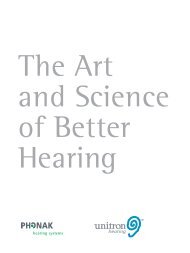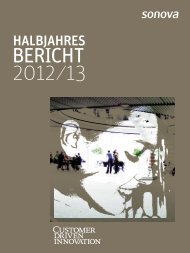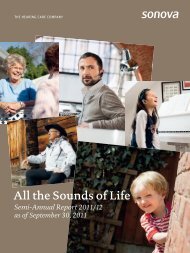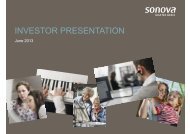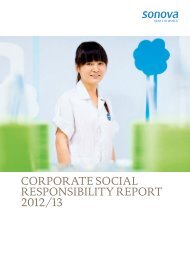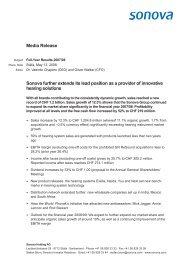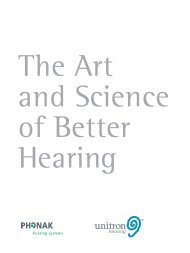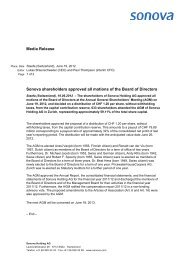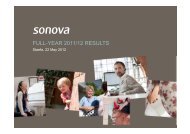Employee benefits (IAS 19)Pension obligationsMost employees are covered by post-employment planssponsored by Group companies. Such plans in Phonak Group aremainly defined contribution plans (future benefits are determinedby reference to the amount of contributions paid) andare generally administered by autonomous pension funds orindependent insurance companies. These pension plans are financedthrough employer and employee contributions. TheGroup’s contributions to defined contribution plans are chargedto the income statement in the year to which they relate.Phonak Group also has a number of defined benefit pensionplans, both funded and unfunded. Accounting and reportingof these plans are based on annual actuarial valuations. Definedbenefit obligations and service costs are assessed using theprojected unit credit method: the cost of providing pensions ischarged to the income statement so as to spread the regularcost over the service lives of employees participating in theseplans. The pension obligation is measured as the presentvalue of the estimated future outflows using interest rates ofgovernment securities which have terms to maturity approximatingthe terms of the related liability. Actuarial gains andlosses are recognized over the average remaining serviceperiods of employees participating in these plans as income orexpense when the cumulative unrecognized actuarial gainsor losses for each individual plan exceed 10% of the higher ofthe defined benefit obligation and the fair value of planassets. Expenses from defined benefit plans are charged to theappropriate income statement heading within the operatingresults.Other long-term benefitsOther long-term benefits comprise mainly length of servicecompensation benefits which certain subsidiary companies arerequired to provide in accordance with legal requirements in therespective countries. These benefits are accrued, and the correspondingliabilities are included under “Other provisions”.Equity compensation benefitsThe Board of Directors of Phonak Holding AG, the ManagementBoard, as well as management and senior employeesof Group companies participate in equity compensation plans.In addition a share purchase plan offering three shares for everytwo purchased is offered to all Phonak employees. The fairvalue of all equity compensation awards granted to employeesis estimated, using a binomial option pricing model, at thegrant date and recorded as an expense over the vesting period.The expense is charged to the appropriate income statementheading within the operating results and an equivalent increasein equity is recorded.3.4 Significant accounting judgements and estimatesKey management judgements made in applyingaccounting policiesIn the process of applying the Group’s accounting policies,management may be required to make judgements, apart fromthose involving estimates, which have an effect on the amountsrecognized in the financial statements.Key accounting estimates and assumptionsPreparation of financial statements in conformity with IFRSrequires management to make estimates and assumptionsthat affect the reported amounts of assets, liabilities, revenue,expenses and related disclosures. The estimates and assumptionsare continually evaluated and are based on experience andother factors, including expectations of future events that arebelieved to be reasonable. Actual results may differ from theseestimates and assumptions.The main estimates and assumptions, with the potential ofcausing an adjustment, are discussed below.Cost of business combinationsA business combination agreement may provide for anadjustment to the cost of the combination contingent onfuture events. If the future events do not occur or the estimateneeds to be revised, the cost of a business combination isrevised accordingly, with a resultant change in the carrying valueof goodwill. As at the end of the financial year <strong>2005</strong>/<strong>06</strong> suchcosts contingent on future events (earn-out and holdback ofpurchase prices) of CHF 16.5 million have been included inthe cost of business combinations.Property, plant and equipment and intangible assets,including goodwillThe Group has property, plant and equipment with a carryingvalue of CHF 117.3 million as disclosed in Note 18 and intangibleassets, including goodwill with a carrying value ofCHF 208.4 million as disclosed in Note 21.The Group determines annually, in accordance with theaccounting policy stated in Note 3.3, whether any of the assetsare impaired. For the impairment tests, estimates are made ofthe expected future cash flows from the use of the asset. Theactual cash flows could vary significantly from these estimates.Deferred tax assetsThe consolidated balance sheet includes deferred tax assetsof CHF 59.1 million related to deductible differences and, incertain cases, tax loss carryforwards provided that their utilizationappears probable. The recoverable value is based on forecastsof the corresponding taxable Group company over a periodof several years. As actual results may differ from these forecasts,the deferred tax assets may be impaired accordingly.Consolidated Financial Statements55
Employee benefit plansPhonak has various employee benefit plans. Most of itssalaried employees are covered by these plans, many of whichare defined benefit plans. The present value of the definedbenefit obligations at the end of the financial period <strong>2005</strong>/<strong>06</strong>amounts to CHF 98.0 million as disclosed in Note 31. Withsuch plans, actuarial assumptions are made for the purpose ofestimating future developments, including estimates andassumptions relating to discount rates, the expected return onplan assets in individual countries and future wage trends.Actuaries also use statistical data such as mortality tables andstaff turnover rates with a view to determining employeebenefit obligations. If these factors change due to a change ineconomic or market conditions, the subsequent results coulddeviate considerably from the actuarial reports and calculations.Over the medium term such deviations could have a significanteffect on income and expenses arising from employee benefitplans. The carrying amounts of the plan assets and liabilitiesin the balance sheet are set out in Note 31.Provision for warranty and returnsThe Group recorded provisions for warranty and returnsof CHF 33.2 million as of March 31, 20<strong>06</strong> as disclosed in Note 22.The calculation of these provisions is based on turnoverand past experience of warranty claims and returns. The actualcosts for warranty and returns may differ from the estimates.3.5 Financial risk managementThe Group is exposed to the following financial risks:Interest rate riskInterest rate risk relates primarily to long-term interestbearing liabilities. The Group’s mortgages as well as a portion ofthe other long-term debts represent long-term fixed-rate contracts,which minimize the risk of changing interest rates.The remainder of the long-term debts are currently subject tomoney market rates. The interest situation and hedgingpossibilities are continuously monitored. Derivative instrumentsare currently not being used to hedge against changes ininterest rates.Exchange rate riskThe Group buys and sells products in foreign currenciesand is therefore exposed to exchange rate risks. To minimizeforeign currency exchange risks, relating in particular tointer-company sales and the settlement of inter-company loans,forward currency contracts are entered into. Generally, thesecontracts do not qualify for hedge accounting treatment underIAS 39, and accordingly exchange losses and gains on forwardcurrency contracts are recognized in the income statement. However,if a forward contract qualifies as a hedge, under IAS 39,such exchange gains and losses on the contract are recordedin equity and are reclassified to the income statementwhen the gains or losses on the underlying transaction arerecorded.Credit riskFinancial assets which could expose the Group to a potentialconcentration risk are principally cash and bank balances andtrade receivables. Banking relations are maintained only with firstclassfinancial institutions. The Group performs continuouscredit checks on its customers and is not exposed to any significantconcentration risks.3.6 InvestmentsPhonak classifies its investments in the following categories:financial assets at fair value through profit or loss, loans andreceivables, held-to-maturity investments, and available-for-salefinancial assets. The classification depends on the purpose forwhich the investments were acquired. Management determinesthe classification of its investments at initial recognition andreclassifies them whenever their intention or ability changes. Allpurchases and sales are recognized on the settlement date.Financial assets at fair value through profit or lossFinancial assets at fair value through profit or loss are assetsheld for trading, acquired for the purpose of generating a profitfrom short-term fluctuations in price or dealer’s margin.Derivative financial assets and derivative financial liabilities arealways deemed as held for trading unless they are designatedand effective hedging instruments. Financial assets held for tradingare measured at their fair value plus initial transactioncosts. Fair value changes on a financial asset held for trading areincluded in net profit or loss for the period in which they arise.Assets in this category are classified as current assets if they areeither held for trading or are expected to be realized within 12months of the balance sheet date.Loans and receivablesLoans and receivables are non-derivative financial assetswith fixed or determinable payments that are not quoted inan active market. They arise when the Group provides money,goods or services directly to a debtor with no intention oftrading the receivable. They are included in current assets, exceptfor maturities more than 12 months after the balance-sheetdate. These are classified as non-current assets. Loans and receivablesare included in trade and other receivables in the balance56Consolidated Financial Statements
- Page 1 and 2:
Annual Report 2005/06Annual Report
- Page 3 and 4:
FIVE-YEAR KEY FIGURES(Consolidated)
- Page 5 and 6:
CHAIRMAN’S FOREWORDIn 2005/06, th
- Page 7: Move with the melody
- Page 10 and 11: digital entry-level product line, w
- Page 12 and 13: MARKETSGeneral market developmentTh
- Page 15 and 16: NEW TECHNOLOGIES AND PRODUCTSPlatfo
- Page 17 and 18: OPERATIONS AND STAFFOperationsWithi
- Page 19: Listen to life
- Page 22 and 23: This report describes the principle
- Page 24 and 25: Capital StructureChanges in capital
- Page 26 and 27: Left to right: Robert F. Spoerry, D
- Page 28 and 29: Andy Rihs (born in 1942) has been C
- Page 30 and 31: Dr. Valentin Chapero Rueda (born in
- Page 32 and 33: Share and option ownership of membe
- Page 34 and 35: Highest total compensationThe highe
- Page 36 and 37: Investor Relations CalendarJuly 6,
- Page 39 and 40: SUSTAINABILITYPhonak’s management
- Page 41 and 42: Our customers buy a better quality
- Page 43 and 44: Corporate GovernancePhonak’s Boar
- Page 45: Push your performance
- Page 49 and 50: Consolidated Income Statement1,000
- Page 51 and 52: Consolidated Statement of Cash Flow
- Page 53 and 54: Notes to the ConsolidatedFinancial
- Page 55 and 56: equity method, the investment in an
- Page 57: Short-term debtsShort-term debts co
- Page 61 and 62: 5. Segment informationProfit or los
- Page 63 and 64: 6. Consolidated Income Statement by
- Page 65 and 66: 9. Financial income/(expenses), net
- Page 67 and 68: 11. Earnings per shareBasic earning
- Page 69 and 70: 17. Inventories1,000 CHFRaw materia
- Page 71 and 72: 19. Investments in associates and j
- Page 73 and 74: GoodwillSoftwareIntangiblesrelating
- Page 75 and 76: Among various other items, other pr
- Page 77 and 78: 27. Other long-term liabilities1,00
- Page 79 and 80: 29. Acquisition of subsidiariesDuri
- Page 81 and 82: 30. Related-party transactionsManag
- Page 83 and 84: The amount recognized in the consol
- Page 85 and 86: Summary of outstanding and exercisa
- Page 87 and 88: 35. Number of employeesAt March 31,
- Page 89 and 90: 38. List of significant consolidate
- Page 91: Cherish the cheers
- Page 95 and 96: Income Statement1,000 CHFIncomeMana
- Page 97 and 98: Notes to the Financial Statements1.
- Page 99 and 100: 3.4 List of significant investments
- Page 101 and 102: Appropriation of Available Earnings
- Page 103: Launch a laugh
- Page 106 and 107: Phonak ABHornsbruksgatan 28SE-117 3
- Page 108 and 109:
ImpressumConceptLithographyPrinting



